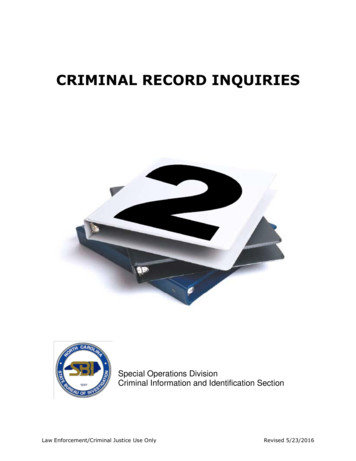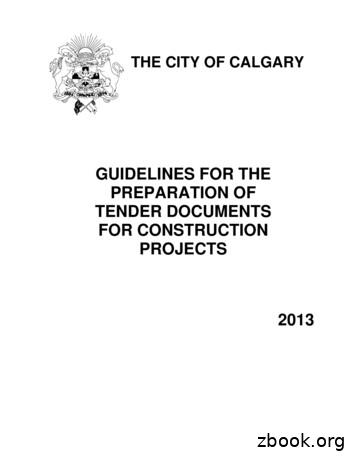Implementation Of Revised AS 1668 Parts 2 & 4 — 2012
Implementation ofrevised AS 1668 Parts 2 & 4 — 2012The use of airconditioning and ventilation in buildingsPart 2: Mechanical ventilationPart 4: Natural ventilation
TopicsOverviewWhy, Where & How of ventilationPart 2 Mech. VentPrincipal changesDetails & Implications of changesPart 4 Natural VentPrincipal changes & Details
OverviewQ:A:Why ventilate buildings?Amenity, Health and the LawoBuildings protect us from wind, rain, hail & heat, butalso shield us from fresh air and capture contaminantsoCooking smells & metabolic odours detract from amenityoLaboratories, factories, etc. contaminate with smells & toxinsoRespect your neighbour. Exhaust mustn’t be a nuisanceoConstruction must comply with BCA, esp. Part F4oAS 1668.2 & AS 1668.4 are both required by Part F4
OverviewHistory of ventilation Standardso Research on ventilation & perception of indoor air quality byYaglou, Fanger et al, 1930s to present: Acceptable to 80% of visitors requires 7.5 L/s/person Acceptable to 95% of visitors requires 9.7 L/s/person More air required if activity is strenuous More air required for dilution if dust content is higho Higher productivity has recently been linked to 20 L/s per persono Australian and international Standards were based on Yaglouresearch — except in 1970s oil price shock!
OverviewHistory of ventilation StandardsSourceSydney Ventilation CodePublication date orPeriodTypical rate per person1963 & 197114.2 l/sCommon Australian practiceASHRAE1970s197211.8 l/s11.8 l/sAS 1668.219763.5 l/sOrdinance 70 (NSW)19785 l/sAS 1668.2Sydney Ventilation Code198019833.5 l/s [2.5 l/s in some cases]3.5 l/sAS 1668.2199110 l/s [ 7.5 l/s to 2.5 l/s]AS 1668.2AS 1668.22002201210 l/ s [ 7.5 l/s to 2.5 l/s]10 l/ s [ 7.5 l/s to 2.5 l/s]2006 & 201420 l/s (Productivity basis)Seppänen & Fisk Bahnfleth Reductions permitted if particulate filters only or odour particulate filters are used
AS 1668 Part 2 - 2012Principal ChangesChanges from the 1991 and 2002 editionsoAll references to smoking removedoMech. ventilation in Pt. 2 & Natural ventilation in Pt. 4oDilution Index of 2002 edition removedoO/A rates generally 10 L/s, with option to 7.5 L/s or 2.5 L/soSimpler outdoor air calculations for complex spacesoMore kitchen hood types & cooking processes includedoAutomatic demand control ventilation allowed
AS 1668 Part 2Principal ChangesoGuidance added on make-up air sourcesoDistance from inlets to small exhausts relaxedo2002 edition car park exhaust rates usedoCar park natural vent. now in AS1668.4oSmall car park ventilation simpler & matches BCAoJet fans permitted to “bend” car park airflowoMechanical ventilation of health care now includedoBig increase in exhaust from pools and spas
AS 1668 Part 2Principal ChangesBCA 2013 & 2014 reference AS 1668.2 – 2012oVentilation of roomsF4.5oVentilation of CarparksF4.11oLocal exhaust ventilation of KitchensoAir conditioning & ventilationJ5.2esp. automatic contaminant control in CarparksF4.12BCA 2014 references AS 1668.4 – 2012oNatural ventilation of Carparks F4.11
AS 1668 Part 2Details & ImplicationsSupply Airo Floor wastes in ducts or plenums MUST always be chargedo Reliance on condensate only is not appropriateEnclosures prohibiting recycle air, increased to 9:ooooRooms where odours/noxious gases are produced or outgassedPet shops, vet centres, kennels, etc.Swimming pools, decks, etcEnclosures containing “Specific contaminants”
AS 1668 Part 2Details & ImplicationsSupply Air Filterso Minimum filter ratings, now based on systems and airflowTABLE 2.1MINIMUM FILTER RATINGSystem characteristicsMinimum filter rating(see AS 1324.1) 1000 L/s ductedG4 1000 L/s non-ductedG4 1000 L/s ductedG2 1000 L/s non-ductedNREvaporative coolersNRLEGEND:NR no requirement
AS 1668 Part 2Details & ImplicationsMinimum Outdoor Air supplyoOutdoor air calculation based on 1991 StandardoConcept of “Effective Outdoor Air” allows credits for: Air-cleaning systems, Transfer from adjacent spaces, Unused O/A in recycle airstream, Odour & particulate filtersoCalculation methods in Appendix DoThese are the minimum values noted in BCA J5.2 (b)
AS 1668 Part 2 - 201225% OAOutdoorAirFirst trial iteration for Outdoor Air flowPlant RoomSupply AirRecycleAirSecondary Office15% OAAirCleanerConference RoomMeeting Room A33% OA25% OAMain Office15% OASpill AirReturn AirAir-handling Unit serving Multiple Enclosures
AS 1668 Part 2 - 201218% OAOutdoorAir3rd iteration for Outdoor Air Transfer AirPlant RoomSupply AirRecycleAirSecondary Office Transfer15% OAAirCleanerConference RoomMeeting Room A33% OA25% OAMain Office15% OASpill AirAirReturn AirAir-handling Unit serving Multiple Enclosures
AS 1668 Part 2Details & ImplicationsDemand Controlled supply ventilationAutomatic operation of Outdoor Air Demand ControlVentilation using population indicators. Options are:o Time-of-day schedulesCO2 sensorsMixed gas sensorsPeople counters
AS 1668 Part 2Details & ImplicationsExhaust AiroSupply air instead of exhaust is permitted where: Discharge is not objectionable, and Adjacent spaces are at higher pressureoFull Kitchen Exhaust exempted when only reheating foodoBUT AS 1668.2 doesn’t cover all exhaust ventilation, referAppendix O eg: Explosion vents, Spray painting, Fumecupboards and Welding booths
AS 1668 Part 2Details & ImplicationsKitchen Hood Exhaust typesoNow 7 different hood types. Additions are: Eyebrow hoods Ventilated ceilings Proprietary equipmentoAnd 7 different cooking process types . Additions are: Oriental cooking tables and woks Bread ovens & steam-producing Combi oven
AS 1668 Part 2Details & ImplicationsCourtesy of Halton“Closed” ventilated ceilings envisaged in the Standard, incorporate direct duct connections tosupply and exhaust
AS 1668 Part 2Details & ImplicationsKitchen Hood Exhaust airflowsoEnergy saving feature. Exhaust velocity can be reduced to0.3 m/sec for hoods over non-grease-producing itemsoFurther reduction to 0.1 m/s if hood volume is increasedKitchen Hood Exhaust dischargesoConcessions allowed on separation from Kitchen Exhaustdischarge to Air Intakes if odour filter or photochemicaltreatment is installed. Calculation methods provided
AS 1668 Part 2Details & ImplicationsFilters &Ozoneodourtreatment
AS 1668 Part 2Details & ImplicationsMake up of Exhaust AirflowoReflecting Section J Guidance is given on maximum flowof air-conditioned air for Kitchen Exhaust make-up airoWarning given on openable windows for make-up ofresidential exhausts. These may not be suitable sources
AS 1668 Part 2Details & ImplicationsSeparation of Exhausts & Air IntakesooooExhaust discharges less than 1,000 L/s not requiredto be 6 metres from air intakesDischarges less than 200 L/s can be 1 metre from intakeBut, multiple discharges less than 1,000 L/s within a6 m radius are aggregated as onePerhaps riser shafts no longer required in apartments?
AS 1668 Part 2Details & ImplicationsProximity of exhaust discharges & openable windows
AS 1668 Part 2Details & ImplicationsCarpark VentilationoMajor reduction in exhaust airflows, based on 2002 edition Small car parks:* 40 cars, same as BCA* Min airflow: 3,000 down to 2,000 L/s* Per vehicle rate: 500 down to 400 L/s* Area rate: 3.5 down to 2.5 L/s per m2 Large car parks:* 20% less flow by calculation* Entering cars not calculated* Extra factors for Vehicle type,Usage & Staff exposure
AS 1668 Part 2Details & ImplicationsCarpark VentilationoMethods for reducing ventilation rates in small carparkssimplified, options for automatic control with door switches& motion detectorsoHigh/Low level exhaust outlets no longer requiredo“Air moving devices” are permitted to avoid extra ductworkwhere air paths are obstructed within the car park.(Impulse fans or Jet fans)
AS 1668 Part 2Details & ImplicationsAir movingdeviceNOTE: This option allowsventilation of “dead ends” incar parks. Not to ventilatethe whole car park
AS 1668 Part 2Details & ImplicationsExamples of AirMoving DevicesCourtesy of Fantech
AS 1668 Part 2Details & ImplicationsHealth Care BuildingsoChange from the 1991 edition, but generally same as2002 editionoApplies to: Operating theatres, Sterile Stores, Infectious &Protective isolation rooms, Recovery rooms, Autopsyrooms and Dirty utility roomsoSpecifies: Supply & Recirculation air change rates,Outdoor airflow, Filtration, Exhaust grille location andRoom pressure versus adjacent areas
AS 1668 Part 2Details & ImplicationsSection 5: Health Care BuildingsPositive PDirty UtilityOperating TheatreSterile StorePositive PNegative PProtective IsolationPositive PNegative PRecoveryAutopsyInfectious IsolationNeutralNegative PRelative Pressure Diagram - Health Care Enclosures
AS 1668 Part 2Details & ImplicationsAppendix A – Minimum effective outdoor airoDilution Index method of 2002 edition has gone. Sameas 1991 edition without smokingoGenerally, all requirements for 15 & 20 L/s per head nowreduced to 10 L/s per headAppendix B – Minimum exhaust ratesoSwimming Pools increased, 2.5 to 10 L/s per m2 andSpa Exhaust from 5 to 15 L/s per m2 15% splash areaoDomestic laundry exhaust doubled, to suit clothes dryers
AS 1668 Part 4 - 2012The Principal Changes
AS 1668 Part 4Principal ChangesChanges from the 1991 and 2002 editionsoGenerally includes text from Sections 2 & 3 of the 2002edition (not in the same order)oCommentary provides pros and cons of natural ventilationoTwo types of natural ventilation are nominated: Simple prescriptive procedure that follows Clauses F4.6& F4.7 of BCA Detailed procedure which refers to Appendix A & B
AS 1668 Part 4Details & ImplicationsCar Park VentilationoNatural ventilation of car parks included with minimalchange from the requirements of the 2002 edition.oMain variation from 1991 edition is addition of methodsfor calculating “Ventilation Coefficients” of differentshapes & configurations of natural ventilation openingsoChanged depth of naturally ventilated carpark from 7mto 9m, with 12.5% open area on outside wall.
AS 1668 Part 4Details & ImplicationsAppendix A & BAdvisory appendicesoA Provides performance-based design requirementsfor Alternative Solutions to natural ventilationoA Includes mandatory references to AS 1668.2, NCC,AS/NZS 1668.1 and CIBSE Guide Vol. A Infiltration &Natural VentilationoB Provides metabolic rates of building occupants forcalculations required by the detailed procedures ofClause 3.5
AnyQuestions?
BCA 2013 & 2014 reference AS 1668.2 – 2012 o Ventilation of rooms F4.5 o Ventilation of Carparks F4.11 o Local exhaust ventilation of Kitchens F4.12 o Air conditioning & ventilation J5.2 esp. automatic contaminant control in Carpa
Student Training Manual/Workbook . 5 Law Enforcement/Criminal Justice Use Only Revised 5/23/2016 Revised By: Revised Date: Revised By: Revised Date: Revised By: Revised Date: Revised By: Revised Date: Revised By: Revised Date: Revised By: Revised Date: Revised By: Revised Date: Marie Jernigan Supervisor Training Unit SBI Criminal Information and Identification Section May 23, 2016 Jeannie .
Translated by Richard Wilbur. . 1666 - The Misanthrope 1666 - The Doctor in Spite of Himself 1667 - The Sicilian, or Love the Painter 1668 - Amphitryon 1668 - The Abashed Husband 1668 - The Miser, or, the School for Lies 1669 - Tartuffe (post-ban 5-act version) 1670 - The Magnificent Lovers
Data sheet Item number: 787-1668/000-054 electronic circuit breaker; 8-channel; 24 VDC input voltage; adj
Standard Hill North Mannville Sands Pool. Revised PO. Standard Hill West McLaren Sand Pool. Revised PO. Storthoaks Tilston Beds Pool. Revised PO. Verendrye Viking Sand Pool. Revised PO. Wauchope Central Tilston Beds Pool. Revised PO. White Bear Tilston-Souris Valley Beds Pool. Revised PO. Workman Frobisher Beds Pool. Revised PB.
4 Rig Veda I Praise Agni, the Chosen Mediator, the Shining One, the Minister, the summoner, who most grants ecstasy. Yajur Veda i̱ṣe tvo̱rje tv ā̍ vā̱yava̍s sthop ā̱yava̍s stha d e̱vo v a̍s savi̱tā prārpa̍yat u̱śreṣṭha̍tam āya̱
3.5 09 (e) Form of Tender (Yellow Sheet) Revised 3.5.13 Prime Contractor Management Status Revised 3.5.14 (a) Bid Bond Revised 3.5.15 (a) Consent of Surety to Furnish Bonding Revised 3.5.17 Waiver Form Revised 4.1 Closing and Awarding of Tenders Revised 4.1 (c ) Closing of Tenders, Evaluation and Award Recommendation Revised
location and survey section survey automation survey feature code guide book prepared by huntington hodges, p.l.s. location & survey assistant administrator december 1, 1999 revised february 1, 2002 revised january 1, 2005 revised october 1, 2005 revised january 3, 2006 revised december 1, 2008 revised january 30, 2009 revised december 1, 2010
Group Piano Course Late Beginner (ages 8 10) Alfred’s Basic Late Beginner (ages 10 11) Chord Approach Adult Piano Course OR All-In-One Adult Piano Course Young Beginner (ages 5 7) Prep Course Beginner (ages 7 9) Alfred’s Basic For the youngest beginner, ages 4–6 Music for Little Mozarts, Books 1–4 lead into Prep Level C. 2























